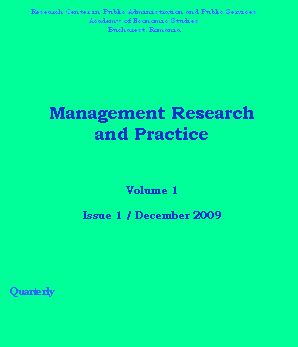
BUSINESS EXCELLENCE AND MANAGEMENT
ISSN
2248-1354 (print)
2668-9219 (online)
ISSN-L: 2248- 1354
|
Home |
|
| Journal description | |
| Aims and scope | |
| Publication ethics | |
| Indexation | |
| Editorial information | |
| Editorial team | |
| Editorial Board | |
|
Journal content |
|
| Current issue | |
| Previous issues | |
| Special issues | |
| Guideline for authors | |
| Submission | |
| Manuscript style | BEMAN Template |
|
|
| Volume 8, Issue 4, December 2018 |
|
Adrian-Constantin ACHIM Romania
|
|
Organizational performance is, and will remain, a priority on the agenda of each manager within the different hierarchy and structures of the Ministry of Internal Affairs and the provision of a modern and professional human resources management based on maintaining a high level of probity and professional integrity for the staff and an increase level of authority in the community, will always be a useful indicator for assessing the efficiency and effectiveness of institutional mid level and top management. The conduct of specific activities directly and closely to the civilian population, the difficulty of permanently assessing the risks associated with police interventions and the existence of various situations that can unpredictably degenerate into actions of destabilizing social order, the deployment of police activity in high risk criminal areas, all associated with insufficient human and logistic resources, may be factors that in most cases influence the authority of the personnel in the public order and safety system, thus affecting both citizens and the ones charged with ensuring, maintaining and restoring public order. The surveys carried out in the past at the level of the specialized centers of the Ministry of Internal Affairs highlighted very clearly the determinants that lead to the diminution of the authority of the personnel. The perception of respondents, both policemen, border guards, gendarmes, was almost the same, being expressed by the fact that the diminution of authority reached a critical level and will continue to inevitably lead to negative effects which will not be easily controlled by the organization and by the state in the medium and long term. The survey conducted last year confirmed the results of the previous ones, the most significant effects occurring, as the interviewees noted, were the constant diminution of the image and credit granted to the institution and its representatives by the different categories of beneficiaries of the public services provided respectively citizens, the civil society, other partner public organizations, aspects translated into a crisis of legitimacy, increasingly negative not only in the public discourse or in the media, but also in the self-image of the employees... |
|
2. COMPENSATION, EMPLOYEE PERFORMANCE AND ORGANIZATION PERFORMANCE IN GUARANTEE TRUST BANK (GT BANK) PLC.
Bolaji Saheed HAMZAT
Nigeria Nigeria
Adedayo Mathias OPELE Nigeria
|
|
In this paper, we moved away from the questionnaire and interview data gathering approach to test the fundamental assumption of HRM practices as they impact both employee and organizational performance using financial data. We argued that performance is better appraised “a posteriori”. Thus, we extracted financial data from the annual financial report from year 2002 to 2012 and the Pearson Correlation method is used to analyze the data. The analysis reveals that there is a positively strong and statistical significant relationship between, firstly, compensation and employee performance (0.815); secondly, compensation and organizational performance (0.666); and lastly, between employee performance and organizational performance (0.903). However, the findings should be treated with caution as these relationships do not imply a causal one. Importantly, the results strengthen the fundamental role of HRM practice of compensation as one of the important drivers of employee performance that culminates into the overall improved organizational performance... |
|
3. ANNEX COMPARATIVE ANALYSIS OF INTERNATIONAL STANDARDS OF FINANCIAL REPORTING AND SOLVENCY II IN SURANCE
Radojko LUKIC Faculty of Economics, University of Belgrade Serbia
|
|
In this paper, the most important regulation in insurance companies is analyzed in a comparative way, with a special focus on International Financial Reporting Standard (IFRS) 17 "Insurance Contracts". The main goal is to simplify these very complex issues as much as possible to "standards", which are more easily applied in the practice of insurance companies... |
Other ASE journals


